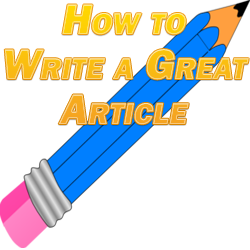The other day in part one of this 3 day “Article Writing Tips” series, I covered how to write a great title that is designed to get people to click through and read the actual article of your article. Today I’m going to talk about how to write a great article itself which will keep your reader engaged all the way to your resource box which (spoiler alert) I’ll be covering tomorrow.
How to Write a Great Article
First off, you need to open with a great introduction. A good introduction will:
- Establish the problem which the reader is having, mentioning why the problem is a problem/it’s effects and why the reader cares about the problem. The “problem” can be easily adapted to most topics from getting rid of acne to learning how to clean viruses from your computer.
- Set up the reader’s expectations for the rest of the article by mentioning your solution to the problem. This is something we did with the title, as well, but it should reinforce the focus of the article so that the reader knows what they should expect so that they’ll read the article in full. As for the solution, you don’t have to explicitly mention the solution, just mention that you have one and it will be revealed through the rest of the article.
- Stimulate your reader’s interest/curiosity. You can do this through an intriguing statement which gets their attention, for example.
- Establish your tone as a writer which will be consistent throughout the rest of the article.
- Establish and begin to nurture a relationship between you and your reader. Make sure you come off as an authority on what you’re talking about right out of the gates.
Next is the body of the article. If your education was anything like mine, in middle school you learned to write in the intro/3 paragraph/conclusion format. This isn’t a hard and fast rule anymore – there’s a world of difference between getting an “A” and making a sale.
Splitting your article up into as many paragraphs as possible is the most effective I’ve found. In other words, 10 short paragraphs is MUCH more preferable over 3 long ones. This keeps people’s attention much more easily because new paragraphs refresh the brain and are easier to read as opposed to a long paragraph of a dozen or more lines in which you can lose site of which line you were reading.
The body of the article itself should describe the solution to the problem. Note that you don’t have to give away the complete solution in the article itself if you’re promoting something which is specifically the solution to the problem.
There’s obviously a difference between explaining WHY the solution works and explaining HOW it works. By sticking to the “why”, you can leave the “how” for your resource box/website.
The final part of the academic format is the conclusion. We’re going to deviate from the academic definition of a conclusion which is that a conclusion is something which is used to recap/summarize your points and is necessary to end your article with.
Again, we’re not going for grades, but sales; therefore when writing a great sales article, the conclusion is superfluous because we have something very different called a resource box which I’ll be talking about tomorrow. Even if you’re not writing for an article directory, you still have a resource box where you’ll likely be linking to your offer, albeit not a literal resource box.
The bottom line is that when it comes to article marketing, especially on article directories, the best way to handle a conclusion is to leave it out completely. Many people (including myself) who have just read a long article and come to the conclusion will instinctively click away and move on once they get to the point where the author begins recapping/repeating themselves, feeling that they’ve finished with that article.
You may be worried that ending your article in this way may be a bit too abrupt. Even if you’re in the middle of a thought when you end the body portion of your article, that’s completely fine so long as you pick it up in your resource box.
On article directories, this makes it look as though the resource box is a linear part of your article. This way it doesn’t look like it’s there for the sole purpose of selling like it absolutely does if you throw a summarizing conclusion in between your body and resource box, thus turning people off and oftentimes making it easier for them to ignore it.
Tomorrow will be the final day of this 3 part series on “Article Writing Tips” and I’ll discuss how to write a great article resource box.
